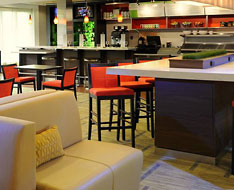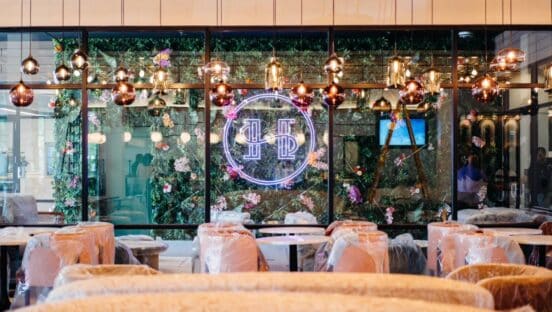Several years ago, Marriott executives determined they were letting revenue walk out the front doors of their Courtyard hotels, which are tailored to frequent business travelers, or “FBTs.” At the time, Courtyard’s breakfast offering was the full-service buffet, familiar to almost anyone who has ever stayed in an American hotel, and their lunch and dinner offerings were negligible.
“For 25 years, we had just the standard buffet along the lobby wall, and it didn’t really give a lot of choice or control to the customer,” says Lon Southerland, director of food and beverage operations for Marriott International.
Besides being an old hat, the buffet did not let time-pressed business travelers grab a quick bite in the morning before tackling a day’s work.
“If they wanted just a coffee and a bagel,” Southerland says, “they’d have to go in, sit down, and wait for an associate to take their order.”
For many business travelers who stayed at Courtyard hotels because the brand billed itself as business-friendly, this did not fit their lifestyle—and they let the company know it. Southerland describes one guest complaining about how each morning he had to go on an “expedition” for breakfast before starting his day.
That expedition often took Courtyards’ guests outside the hotel for meals, depriving the properties of revenue they could capture, at least in part, with a better food and beverage strategy.
Eventually the company took the hint and started developing a new food and beverage plan as part of an overall redesign of its lobby space. So much had changed in a generation, and 21st century travelers, business or otherwise, had distinct and new expectations.
“The way it used to be, the lobby was designed with the assumption that the guest was going to lock himself up in his room,” Southerland says.
But that is no longer the case. The modern business traveler “very much likes to be in an active area but to have his own space,” à la Starbucks and Panera Bread, Southerland says. This means being able to plug in a laptop—“the center of the FBT’s life”—in the lobby while enjoying a cup of coffee and the hubbub of fellow guests.
Technology was a major factor in Marriott’s new strategy, as mobile phones and portable computers have freed business travelers from the confines of the office and allowed them to work on the go.
“The travelers of the past were very work, work, work,” Southerland says. “But now we get off the plane, we check our Blackberrys, we get caught up on our e-mails. By the time we hit the hotel, we have a little more time than we used to.”
On November 1, 2007, after a thorough development process that included building a to-scale model lobby in a San Francisco warehouse, Marriott implemented its prototype in a Courtyard in Fair Oaks, Virginia. As of late July this year, 170 Courtyards had been revamped around the country.
The hotel’s new public space features “welcome pedestals” manned by receptionists, a large touch screen called a “Go Board” where guests can get localized information, and stations for printing airplane boarding passes.
The centerpiece of the redesign is the Bistro, the tagline of which is “Eat. Drink. Connect.” A fast-casual concept, its eclectic menu includes grab-and-go and sit-down breakfast items, soups (“kettleworks”), deli sandwiches and burgers (“breadworks”), ribs and pizzas (“ovenworks”), several salads (“lettuceworks”), and a handful of snacks (“snackworks”). The menu also includes cocktails, wine, beer, and Starbucks coffee. Bistros in smaller Courtyards offer a pared-down menu.
The Bistros sport a lounge-like atmosphere, with chic couches and colorful throw pillows, curving countertops, communal tables with bright-colored chairs, wooden floors, oversized rugs, modern lamp lighting, and big-screen TVs.
The Bistro, Southerland says, transformed the lobby from a place guests pass through into a place they congregate.
“It has really activated the lobby space,” he says. “There’s a lot of foot traffic. There’s a lot of folks hanging out. It’s very similar to a Starbucks, with people interacting all day long.”
One of the challenges in designing the Bistro, Southerland says, was figuring out how to incorporate a restaurant into the lobby without compromising the look and feel appropriate to a hotel.
“We could have had a bunch of grab-and-go cases and had it look highly retail, and that might have stuck out like a sore thumb,” Southerland says. “What we were really driving for was something that fit into the space and made sense as part of the whole.”
Laura Mandala, a hospitality industry analyst who worked with Marriott International for 13 years, says Marriott’s Bistro concept is a direct reflection of customer feedback.
“Guests are saying they want something tasty, fast, and convenient,” says Mandala, who has interviewed hundreds of Marriott customers over the years. “Whether they are business travelers or leisure travelers, it’s an additional hassle for them to have to go somewhere else for food.”
Mandala says the Bistro’s design and its emphasis on facilitating connections—between people who are sitting at communal tables as much as between laptops and WiFi networks—targets a new wave of Generation X and Generation Y business travelers.
“The convenience spans all generations and everyone appreciates the bigger range of options,” Mandala says. “But Gen X and Gen Y travelers don’t want to be sitting in their rooms.
“Connection is a big word,” she says.
While offering a fast breakfast is not a revolutionary concept in the hotel industry, catering to the dinner crowd is generally a new phenomenon. Few Courtyards served food in the evening before the Bistro came along, even though “there were a lot of guests who would have preferred to stay in for dinner if they had a choice,” Southerland says.
The Bistro was designed in part to give Courtyard guests that choice, and with its selection of alcoholic beverages, it also offers weary business travelers an opportunity to unwind after the workday.
The Bistro arose in response to customer input as well as the imperatives of a new age of technology, and in many ways it appears an appropriate response. But almost three years after the first Bistro opened, not everyone is ready to call the concept an unqualified success.
Dan Simons, a principal at hotel and restaurant consulting firm Vucurevich | Simons Advisory Group, says one of the hottest topics in the hotel industry is how to devise better food and beverage strategies. He says hotels had the “sensible thought” that in certain locations they could grab a piece of the lunch crowd from local restaurants. But industry wide, including in the case of the Courtyard Bistro concept, they have fallen short.
“They had a hypothesis that, in addition to pleasing the hotel guests, they could market the Bistro to local businesses and capture restaurant sales,” Simons says. “It’s my understanding that they thought that, they tried that, and that that didn’t pan out.”
Southerland focuses on the Bistro’s positive reception among guests, citing a 27 percent increase in “intent to recommend” and “intent to return” scores at revamped locations. He also offers anecdotal evidence of local patronage—spotting a group of women in tennis outfits having coffee at a Courtyard that did not have tennis courts, for example. But in communities with Bistros, “there are many people who still don’t know about the concept,” he says.
“We don’t see a ton of local patronage right now,” Southerland says. “But that’s because the concept is so new.”
One of the reasons the Bistro may not be catching on beyond Courtyard guests is that Americans generally do not associate hotels with eating out (as opposed to Europeans, who have long frequented local hotels for a meal).
“It’s not compelling for the people who live or work in the area to get their breakfast or lunch from inside a hotel,” Simons says. “I don’t think Americans are up for that. In the U.S., you think of a hotel, you think of a room night.”
Another issue is more basic: Hotels have far more expertise in offering mattresses than meals. The restaurant business is a notoriously difficult one, so it’s no surprise hotels expanding their foodservice operations would struggle to get their bearings. This is true of hotel chains in general, Simons says, not just Marriott.
“In order for it to be successful, the hotel operator has to think like a restaurateur,” says Simons, citing Hyatt Place, Cambria Suites, and Aloft as other chains looking to improve their food and beverage strategies. “I don’t think anyone has it perfected yet.”
To be sure, the Bistro brand is a work in progress, even as it expands to more Courtyard locations. The mission, Southerland says, is gaining an ever-stronger grasp of the nuts and bolts of the fast-casual restaurant business.
“In managing the growth of the Bistro, we want to make sure that we focus on training, execution, product consistency, and distribution,” he says.
If Courtyard’s Bistros have so far failed to take business from local restaurants, not everyone is disappointed. Erik Wolf, managing director of the International Culinary Tourism Association, worries that branded hotel-chain restaurants could hurt local eateries around the country that thrive on tourist dollars.
“If we do not collectively support small, local, and independent restaurants, then in 10 years we as consumers and travelers won’t have any choices when it comes to food,” Wolf says. “There will be one coffee company, one pizza company, and one doughnut company.”
Southerland, however, says the “Go Board” feature at revamped Courtyards, which advertises local establishments based on guest recommendations, should keep local businesses full of new comers.
Mandala says the Bistro’s threat to local restaurants is minimal because few travelers hungry for good, regional cuisine are going to look for it in a hotel lobby.
The Bistro “has a limited offering,” she says. “It’s there to offer guests what they want in the morning and snacks late at night for the convenience of the guest. They are not trying to replace Memphis barbecue.
“I don’t see this as detracting from local restaurants at all,” she says. “That’s not who the hotels are competing against.”
That’s good news for restaurants, particularly considering Marriott’s ambition to implement Bistros in more than 250 locations by the end of 2010. The target for 2011 is to exceed 500 locations nationwide.
Southerland says Marriott plans to continue “evolving, nurturing, and fine-tuning” its food and beverage program.
“Success is never final,” he says.




